Winter is coming. No, not the Game of Thrones winter, you’re going to have to wait forever for that. Winter is coming to your homestead.
And while the weather is still generally mild, and days grow shorter, there is a ton of work to do. Here are thirty chores you should do on your homestead this autumn, to set you up for success in winter and beyond.
In The Garden
#1. Clear Out Your Old Dead Plants
After first frost, most of your vegetables will be played out. Don’t let the old plants linger. Besides being an eyesore, the remains of old dead plants can make planting next season’s crop difficult if you just leave them there. Instead, harvest all the remaining vegetables, and then remove the dead plants from your garden.
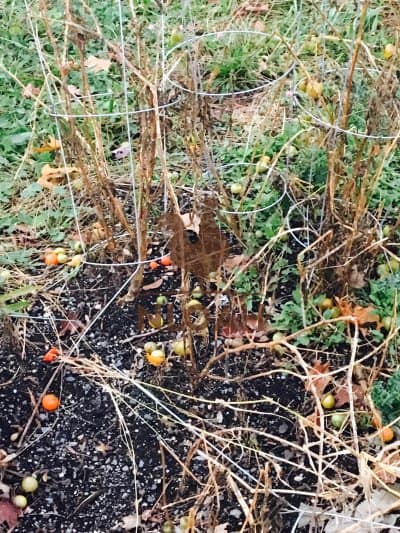
You can feed them to your livestock, or add them to your compost bin (more on compost bins later). Salvage all of your stakes, poles, and other plant support materials to use next season as well.
#2. Add Cold Frames To Winter-Hardy Plants
First frost and the coming winter don’t necessarily mean gardening is over. You can extend your harvest through the fall and beyond with the help of a cold frame. A cold frame is a glass-covered box, which is used to cover plants during colder weather.
The glass cover allows the box to trap warm air, and helps to extend the growing season even as the weather grows colder. Greens like kale and hardy crops like beets and radishes are great cold frame candidates. Cold frames are easy to build, and inexpensive to buy, so get one and put it to work for you this fall.
#3. Clear New Growing Space in Your Garden
If you don’t want to fight Mother Nature, then the fall is one of the best times to start clearing out new growing space in your garden.
Select an area of your lawn, or part of a field that you want to cultivate. Then, simply cover that area with a plastic tarp or cardboard. Weigh down either material with stones or cinderblocks, so it doesn’t just blow away. In the spring, remove the tarp. All of the vegetation should have died off, and you’ll be ready to amend the soil and plant your vegetables.
#4. Plant Those Fall Crops
Autumn isn’t just a time to pack it all in, garden-wise; there is also an opportunity to plant crops for harvest next spring and summer as well. Many gardeners will plant crops like garlic and onions in the fall. The plants will mature throughout the cold weather, and be ready to harvest during the warm weather the following year.
Broad beans, peas, and asparagus are other vegetables that you can plant this autumn, and then harvest when spring comes around as well.
Around Your Property
#5. Mend Those Fences
Fall is a great time to check your fences and make any necessary repairs. As the weather grows colder and small game animals become scarcer, predators will likely start casing your homestead; poultry and other small animals are especially vulnerable to coyotes and other predators during the colder weather.
Take advantage of the vegetation dieback after first frost to walk your fence line, and make sure it’s secure. Replace any rotted or broken timbers, and repair or cover any torn or rusted out wire. Make sure that interior fences, like those on chicken runs, are in good order as well. Make the predators have to work for it this winter!
#6. Clean The Yard
Autumn is a great time to get your property in good shape. If you don’t do some good fall cleaning, your yard will end up looking like a construction site when spring thaw comes around. Rake those leaves and get rid of them (preferably in your own compost pile, see below).
Cut up any junk lumber or fallen tree branches; you can use them for kindling later in the winter. Put tools and terra cotta pots away, before the freezing weather does them in. When the snow melts, and your yard is clean, you’ll be happy you put in the effort.
#7. Build A Compost Bin
As you conduct your autumn chores, a significant amount of organic material is going to pile up. You’re going to have giant mounds of leaves, dead vegetable plants, and other outdoor trash to contend with. So why not build a compost bin?
Compost bins are easy to construct; you can make them out of excess pallets, or the scrap wood that tends to accumulate on a homestead.
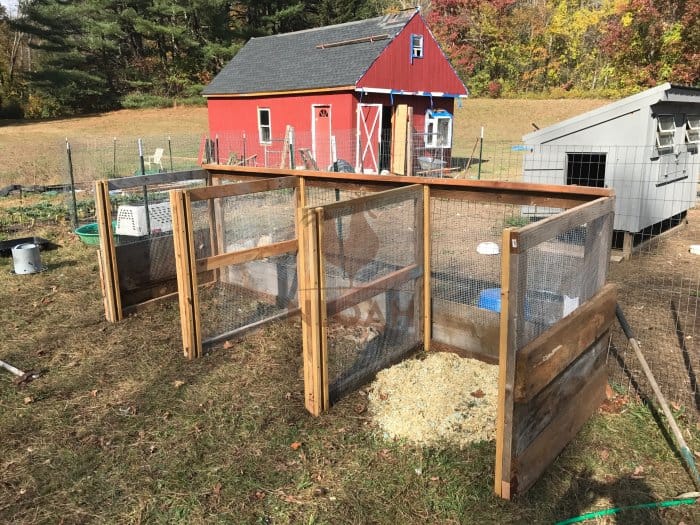
A compost bin will help turn the fall trash you’d normally have to haul away into “black gold” you can use to improve your garden soil. If you’re interested in learning more about building a compost bin this fall, you can check out this video here:
Exterior Work
#8. Barn And Outbuilding Maintenance
Autumn’s the time to make sure your barns and outbuildings are ready for the long, cold winter. Ensure the doors are all in good order; replace any hinges or hasps that could lead to a blown door in a bad winter storm. Secure all of the barn and outbuilding windows as well, so they don’t accidentally let too much cold air (or an unwanted critter) in.
Place some traps or poison down to keep the mice and rats at bay this winter, too. You should also replace any light bulbs now, before it’s too cold to get up on a ladder. Finally, while the weather is still mild, give your barns and outbuildings one final cleaning.
#9. Get Those Poultry Chores Done
As the cold weather approaches, get all of your flock ready for it! Pull those heated poultry founts out of storage, or buy some new ones.
Make sure they work now, so that your birds always have water in freezing temperatures. Stock up on hay now, while the weather is good, so you’re not in a pinch later on when the roads are bad.
Check and make sure your chicken coop is ready for winter, too. If you use a warming light in your henhouse, now would be a good time to place a new bulb inside it.
You should also inspect the coop’s roof, windows and doors and ensure they’re serviceable. Finally, fall is a great time to inspect your flock, and cull any older birds that might struggle during the winter as well.
#10. Winter Prep Your Home’s Exterior
Go ahead and get your home ready for the cold weather while you’re at it. If you use individual air conditioners, go ahead and remove them now, the warm weather is done. While you’re at it, you should also replace your screens with storm windows; this will increase your home’s insulation, and save you considerably on your heating bills.
Clean all of those leaves out of your rain gutters, too. You should also check your chimney, and make sure it is ready for several months of fires.
If it appears blocked, you should hire someone to address the problem, or clean it yourself. In most cases, cleaning your chimney is relatively straightforward. Here is a great video that can runs through the basics of chimney cleaning:
Garage And Car Prep
#11. Garage Maintenance
Much like outbuildings, your garage’s importance only increases during the cold weather. You’ll work in there when the weather is too rough outside, you’ll keep important equipment there, and you will probably stow your vehicle there all winter as well.
Clean and organize your garage as autumn sets in. Ideally, you’ll want enough space to park your car and keep important equipment readily available.
#12. Vehicle Prep
Get your car or truck ready for the cold weather now. Put your snow tires on it so it’s ready for winter driving. Check and make sure you’ve got an ice scraper on hand; if not, go ahead and buy one.
You should also get any key vehicle maintenance that’s due – oil changes, radiator service, or tune ups – complete before colder temperatures make these chores unbearable.
#13. Winter Tool Inventory
Make an inventory of all of the tools you’ll need to get your homestead through the colder weather, and make sure they are on hand. Here is a good starter checklist:
- Snow shovels
- Axe
- Maul
- Wedge and sledge hammer (for log splitting)
- Chainsaw
- Generator
- Salt or de-icer
- Matches or cigarette lighters (for fire starting)
- Flashlights and extra batteries
- Candles
- First aid kit
Add items to this list as you think of them, and then make sure you have them on hand.
Heating System Chores
#14. Wood Stove Maintenance
Autumn is a great time to make sure your fireplace or woodstove is in good order. Go ahead and clean it out completely, removing any ash or debris left from last season.
Make sure that the doors and vents are all functioning properly, and get any necessary repairs done as soon as possible. Finally, start a small fire and make sure that your whole stove is in working order. You’ll rest easier if you know your stove is ready for the cold winter days that are coming.
#15. Firewood Prep
Do you have enough firewood on hand? If not, you better get to work! Get as much seasoned firewood on hand as you need before winter sets in. If you have land, you can cut it yourself; otherwise, you’ll have to buy it.
Split and stack the wood in a secure place as soon as you can, so it is dry, seasoned, and ready to burn. Make sure you have sufficient kindling on hand as well, so that starting a good fire is not a major chore.
#16. Furnace Maintenance
Autumn is a great time to make sure your furnace is ready for the coming cold weather as well. Test your thermostat to make sure your furnace is functioning properly; get it maintained promptly if it isn’t. If you have an oil system, fill your tanks up before prices rise during colder weather.
Finally, make sure that you haven’t blocked heating vents in any rooms over the summer, otherwise your furnace’s best work will all be in vain.
In The Field
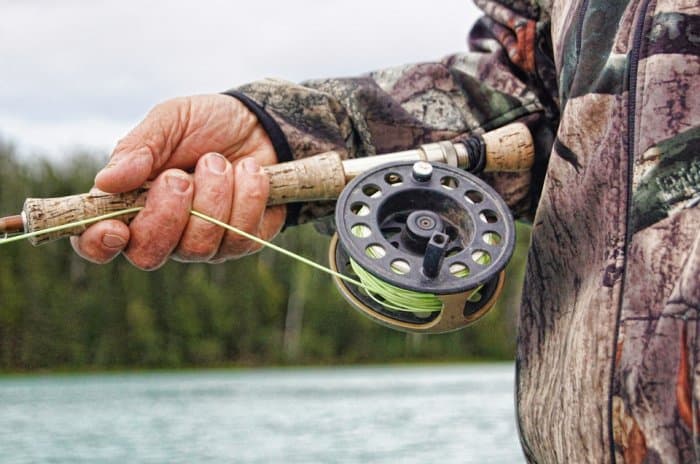
#17. Last Catch
Before the weather gets too cold, fall is a great time to head out on the water and try to catch a few more fish. In some cases, you may have better luck than you would have during the dog days of late summer. The trout and bass fishing often improves during the cooler days of autumn; predatory game fish like pike, pickerel, and muskellunge are often more active as well.
On the coasts and in rivers, striped bass and bluefish are often quite plentiful at this time of year. A few good days of fishing could leave your freezer in good shape for the winter.
#18. Get Game
Autumn is usually prime hunting season in most parts of the country. Deer, turkey, pheasant, quail, and small game seasons kick off just as the weather gets cooler. A lucky day or two of deer hunting can set you up with over a hundred pounds of meat for the winter.
Likewise, a successful turkey or rabbit hunt can add variety to your table fare as well. So check your hunting regulations, and hit the field as soon as you can.
#19. Forage Afield
Autumn is also a great time to forage in the woods for the wild harvest. Most of the best mushrooms appear in the early days of fall. You can head out and find morels, giant puffballs, or other great mushrooms, and enjoy gourmet meals as days grow shorter.
Autumn is a great time to pluck fat dandelion roots out of the soil, or cattail rhizomes. You can also find chickweed and wild mustard greens out there as well. So take advantage of the free table fare that is out there in the forest this autumn.
[NOTE: do not forage for mushrooms or wild plants unless you are absolutely certain of what you are doing. Try to bring along an experienced forager until you are comfortable identifying these items.]
In The Home
#20. Safety First
Autumn is a great time to check all of the safety items around your household. Change out all of your smoke detector batteries, and test them all to make sure they work; do the same with your carbon monoxide detectors.
Inspect all of your fire extinguishers, and make sure they are functional as well. Replace any burned out light bulbs around your house, particularly on staircases and entryways. Make sure your candles and flashlights are handy too, so you’re ready for storms that knock out your power.
#21. Swap Out Hot Gear For Cold
The cold weather is coming, so get your wardrobe ready for it. Put warm weather items, like shorts, t-shirts, sandals, and the like in trunks, boxes, or the backs of closets. Pull out your coats, hats, gloves and boots, so you are ready for when the freezing weather hits.
Head to the store if you need to replace any cold weather items that you’ve lost or worn out since last winter. You should also pull out and clean your heavy winter blankets, and put them on your beds as well.
#22. Don’t get Bored. Get Board Games!
Don’t let the cooler autumn weather turn your family into a bunch of disengaged couch potatoes. Keep your kids (and spouse) off of the Xbox and Internet by investing in some great board games. Buy some classic games like Monopoly, Risk, or Life, and pick a day each week to play together as a family.
If you are really adventurous, buy some more complex games, like Settlers of Catan or Dungeons and Dragons. A small investment in games like these can entertain your family, and bring you all closer together at the same time.
Pantry Prep
#23. Yes You CAN!
Fall is a great time to fill your pantry’s shelves with jars of goods you’ve canned. Turn those late season tomatoes into jars of tomato sauce and paste. Pickle your late season cucumbers, carrots, squash and beets. Make applesauce or apple butter with a readily available fall apple crop.
Try to can and preserve as much of the fruits and vegetables that are harvested in the fall. Pantry shelves lined with mason jars will give you peace of mind on those cold winter days.
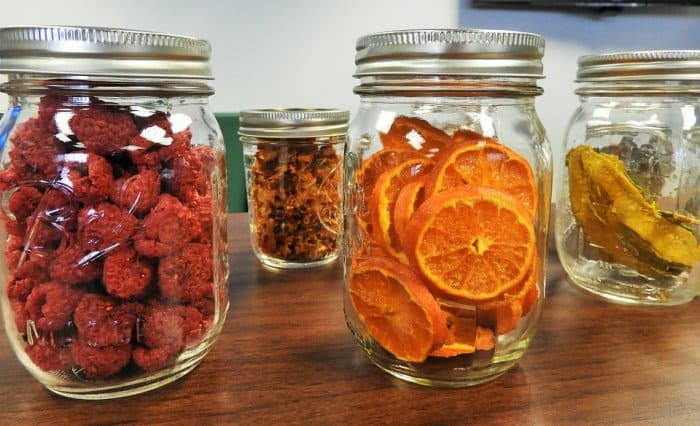
#24. Dry, Freeze, or Smoke It
Canning is great, but it shouldn’t be the only way you preserve foods this fall. Use a dehydrator or your oven to make some long lasting dried foods; fruit leather, beef jerky, and fruit chips are great, nutrient-packed foods that will serve you well in colder weather.
Smoked meats or fish will help add variety to your winter meals as well. Finally, when all else fails, make sure you stock your freezer with meats and vegetables as well.
#25. Home Brew
Autumn is a great time to ensure you have some wine, beer, or cider on hand in the New Year. You can purchase apple cider from many orchards and ferment it, or grind and crush the apples yourself.
Many grapes are harvested in the fall, so it is the perfect time for winemaking as well. Finally, if you brew your own beer in early autumn, it will likely be ready to drink before the first snowfall. So get brewing.
#26. Stock Up
Autumn is a great time to fill up your pantry with store-bought canned and dry goods that you cannot produce yourself. Make sure you have sufficient sugars and starches on hand to sustain you through the winter months.
Getting Thrifty
#27. Head to the Thrift Store
You’ve cleaned your barns, outbuildings, and garage out, so you no doubt have some junk to get rid of. Don’t throw them away; instead, donate all of your unwanted serviceable items at your local thrift store. You’ll likely be able to claim the donation next spring, when tax season rolls around.
While you’re there, look around for items that you can pick up cheaply; you may be able to find a coat or a pair of rubber boots that you can use while doing messy chores around the homestead this winter.
#28. Browse Craigslist
Autumn is a good time to find great deals on Craigslist. Someone in your area will have upgraded their woodstove, and will be trying to unload their old one at a deep discount.
Other people may be downsizing their poultry flock or livestock as cold weather sets in; sometimes you can get chickens and animals for next to nothing. Make sure you peruse Craigslist every day throughout the fall, and snatch those good deals before they’re gone.
#29. Search For Deals.
As autumn arrives, many of the big box stores will be working hard to reduce their summer inventory; they need to make room for those winter items they can sell at a premium.
You should drive by your local Walmart, Lowes, or Home Depot a few times each week. Chances are you’ll be able to get some great, discounted prices on outdoor items like grills, lawn furniture, summer clothing, and the like.
Closing Thoughts: The 30th Chore
This is by no means a complete list; only YOU know all of the chores you need to do this autumn to get your homestead ready for winter. But hopefully it has gotten you thinking about how to best invest your time this autumn. So make your list of chores that need to be finished, and get to work.
And when you feel confident that all your tasks are done, make sure you remember to do one final autumn chore: take stock of everything you’ve accomplished this season. Sit down with a cup of coffee, or something stronger, and think about all the work you’ve put in over the spring and summer.
Take time to be grateful for everything you have on your homestead. And then start thinking about everything you want that homestead to be when the winter ends, and it’s time to get back to work.
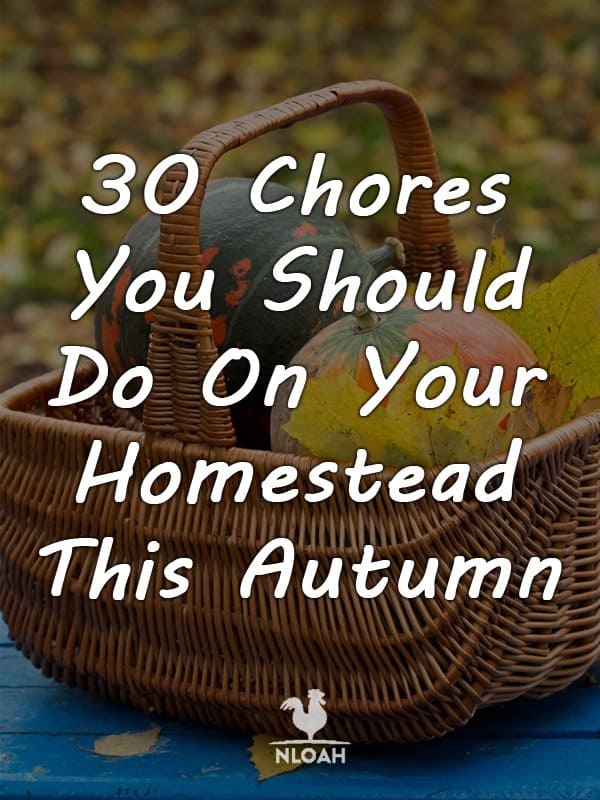
When Tom Harkins is not busy doing emergency repairs to his 200 year-old New England home, he tries to send all of his time gardening, home brewing, foraging, and taking care of his ever-growing flock of chickens, turkey and geese.

Great list of reminders. Thank you.
Thank you Chris! What are your favorite or must-do chores around your own homestead in the fall?
This is a very good list Dan. I am liking what I am seeing with the take over. Keep up the good work.
Thank you! There’s lots more coming
The compost bin section the references a video. However, I don’t see a link to the video. I would be interested if you can find that to post or send to me. Thanks!
Fixed
I dry oranges for Christmas decorations only, I see you have a picture of them canned. How would you use them in a culinary way?
Vickie,
The oranges in the photo were dehydrated and stored in a canning jar. If you use a vacuum sealing machine attachment for Mason jars, it helps to preserve your dehydrated foods longer than simply putting them in a jar with a lid. You can reconstitute the oranges with just a few drops to a half teaspoon of water and use them in recipes or to munch on as a snack. You can also chop the oranges and throw them into the cook pot when you are making any recipe that calls for oranges, in jams, or slice off the peel to get the zest to add to recipes. Dehydrated oranges sprinkled with a little cinnamon, or vanilla extract (or both) make a yummy smelling DIY potpourri.